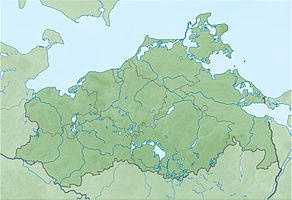Nature reserve cormorant colony near Niederhof
|
Nature reserve cormorant colony near Niederhof
|
||
|
Nests of the cormorant colony |
||
| location | Northeast of Brandshagen in Vorpommern Mecklenburg- district Vorpommern-Rügen | |
| surface | 27 ha | |
| Identifier | LU MV 62 (PDF; 217 kB) | |
| WDPA ID | 9331 | |
| Geographical location | 54 ° 15 ' N , 13 ° 12' E | |
|
|
||
| Sea level | from 12 m to 22 m | |
| Setup date | December 23, 1954 | |
| administration | LUNG | |
The nature reserve Kormorankolonie near Niederhof is a 25 hectare nature reserve in Mecklenburg-Western Pomerania about two kilometers northeast of Brandshagen .
geology
The terrain lies at a height of between 0 and 5 meters above sea level and slopes down to the Strelasund , in some cases several meters high cliffs. Below this formation are flat bank sections with reed beds . The site belongs to the clay slabs landscape unit north of the Peene . It is part of a wavy ground moraine from the last Glaciation of the Vistula . In the area of an extensive breeding colony is cormorant with a plurality of water carrying depressions and potholes . The state of the area is good, as the cormorant colony has been preserved despite massive interventions in the breeding population.
history
Archaeological excavations in 1973 unearthed fragments, among other things, which indicated a settlement in the Neolithic Age . In the north-western part of the protected area, the existence of a Slavic rampart was also proven. In 1760 the Stralsund Chamber Councilor Giese created an estate park, which was a popular weekend excursion destination for Stralsund families until 1930. At a later date it was the country seat of the von Bismarck-Bohlen family. They built the so-called “white castle” in the western part of the park. Niederhof was a manor until 1945. Two years later, in 1947, the castle burned down. In the northern part, on the banks of the Strelasund, there was a vacation home of the district council during GDR times . In the western part of the area is a former Jewish cemetery from the 18th century. With effect from December 23, 1954 it was placed under protection.
Flora
Ash-beech forest is growing in the area . Black alder grows in the damp lowlands. The castle wall is lined with linden trees, as is an avenue that led from the park to the former castle. The oaks used as eyrie trees have largely died due to the corrosive effects of the bird droppings. The following tree species are then ash , chestnut and sycamore maple . The latter, together with the Norway maple, dominates the area around the Jewish cemetery. Typical representatives of the herb layer are forest ringelkraut , forest flutter grass, hazel and forest violets . The otherwise vegetation-free soil is enriched with nitrate through the bird droppings, which has been shown to favor nitrogen-loving plants. In the spring blooms on open surfaces, the wood anemone ; Black alder trees prefer to grow in the damp depressions.
Wildlife
The first eight breeding pairs settled in 1952, after extensive reenactments and subsequent decline at the old breeding site on Rügen ( Pulitz peninsula on the Kleiner Jasmunder Bodden ). They mated around 50 pairs of gray herons that have already settled there. Their numbers increased to up to 258 breeding pairs in 1991. The cormorant population has increased significantly in the last few decades. In 1963 there were already 1186 breeding pairs. After foresters reduced the population of old trees and thus the number of available eyrie trees decreased, the population of Komoran pairs also decreased. It went back to 480 breeding pairs in 1979 and 1980, only to increase again from 1980. In 1990 population pressure led to a second settlement in an eastern lowland. In 1998, 1835 breeding pairs were recorded, with the population growing again after the breeding trees on Tollow Island collapsed . At that time around 1000 breeding pairs migrated to Niederhof. In the same year 194 breeding pairs of the gray herons were counted. There are also woodcock , jackdaw , miniature flycatcher , black woodpecker , chaffinch and goldhammer .
Public use
The area is crossed by a coastal footpath that runs from Trent via Stahlbrode to Brandshagen. An avenue leads through the area from the west. Traffic safety only takes place in this area. There is no forest management. Several information boards inform visitors about the special features of the area. For example, there is a warning about dead wood .
literature
- Environment Ministry Mecklenburg-Western Pomerania (Hrsg.): Kormorankolonie bei Niederhof 6 in: The nature reserves in Mecklenburg-Western Pomerania. Demmler-Verlag, Schwerin 2003, p. 212 f.
Web links
- NSG regulation
- Map portal environment of the State Office for the Environment, Nature Conservation and Geology Mecklenburg-Western Pomerania ( information ) with geodata
Individual evidence
- ↑ Information board NSG Kormorankolonie Niederhof , set up on the avenue, August 2018.





